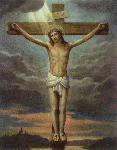
Basic Scripture
By: William G. Most
(c) Copyright by William G. Most, 1993
| HOME |
|---|
CHAPTERS
- Introduction
- A Revolution by Vatican II?
- What is Inspiration ?
- A Revolution by Pius XII?
- Using Genre to defend Inerrancy
- How to Interpret Scripture
- The l964 Instruction of the Biblical Commission
- Which are the Inspired Books?
- The Pentateuch
- Genesis
- Exodus
- Leviticus, Numbers, and Deuteronomy
- Joshua, Judges and Ruth
- Samuel, Kings, Chronicles and Ezra-Nehemiah
- Pre-exilic Prophets
- Exilic and Post-exilic Prophets
- The Psalms
- The Wisdom Literature
- Daniel
- The Two Books of Maccabees
- Judith, Esther, and Tobit
- The Gospels
- The Acts of the Apostles
- St. Paul's Epistles
- The Catholic Epistles
- Study Questions
- Selected Answers
Books/Resources
by Fr. Most
- EWTN Scripture Q & A
- Basic Scripture
- Bible Commentaries
- Our Lady in Doctrine And Devotion
- Outline of Christology
- An Introduction to Christian Philosophy
- The Living God
- The Holy Spirit and The Church
- Catholic Apologetics Notes
Apologetic Resources
- Ask Father
- Biblical Catholicism
- Theology/Philosophy
- Scripture Resources
- Scott Hahns Lectures
- Apologetics Links
Other Services
- Catholic Chaplaincy
- St. Anthony Communications
Chapter 20
The Books of Judith, Esther, and Tobit
In Daniel we saw two genres, one of which was the edifying narrative type.
Now we have a large example of this type in the story of Judith, and
perhaps in Esther and Tobit.
Judith, an extremely beautiful widow calls the elders to hear her plan. Counting on God, she adorns herself, goes to the enemy camp, and is taken before Holofernes. She told him the Jews can easily be conquered since they were about to sin by eating consecrated food. Holofernes invites her to a private banquet. There he becomes very drunk. Judith beheads him while he is in the drunken stupor. She takes his head back to Bethulia. She then is led in triumph to Jerusalem, and composes a hymn of thanksgiving, and lives to a great age.
It is obvious that the story is fictional, e.g., Nebuchadnezzar (605-562) was king of Babylon , not Assyria, and is pictured as reigning from Nineveh, which fell in 612. Also, the Jews are said to have just come back from exile and to have rebuilt the temple - all impossible.
The text exists only in Greek.
Ahasuerus, King of Persia - probably the same as Xerxes (485-65) at a banquet tells his queen Vasthi to come with her royal robes so he may display her beauty to the guests. She refuses. The king is angry and she is deposed. He then orders a search for the most beautiful successor to her. Esther, a Jewess is chosen. Mordecai, her cousin and former guardian, learns of a plot to kill the king and informs him through Esther. Soon after this, Haman, the prime minister, is angered at Mordecai's refusal to pay him homage. He obtains an edict for the extermination of the Jews, but Esther invites him to a banquet with the king, and there reveals what Haman plans. The king is furious, Haman is executed. Mordecai is made prime minister, and all the Jews are authorized to defend themselves - for the order, a decree of the Medes and Persians, which the King had given, cannot be undone.
The feast of Purim commemorates the rescue. Pur means "lot". Haman had cast lots to determine the day for the slaughter of the Jews.
Is this another fictional story? It is more difficult to say. Most scholars today would say it is fictional. Yet the story shows good knowledge of Persian customs. Archaeological evidence shows there was a prime minister Mordecai at about the supposed time of the story. And there are references to official documents in 2:23; 6:1; and 10:2.
It exists in a shorter Hebrew form , and a Greek form with additions of 107 more verses telling the dream of Mordecai, the prayer of Mordecai, edicts of the king, a second account of Esther's appeal to the king, the prayer of Esther. The Hebrew form does not mention God, the Greek makes divine intervention the key to the solution. And the existence of the Feast of Purim is some evidence for historicity.
The devout man Tobit is in exile "in the days of Shalmaneser, King of the Assyrians". He has to flee from Nineveh because, contrary to edict, he has buried the bodies of slain Jews. He returns, but becomes blind from bird dung falling on his eyes while he was asleep.
Meanwhile at Ecbatana in Media, Sarah, the daughter of Raguel, a kinsman of Tobit is sad since the demon Asmodeus killed four husbands of hers successively, each on the wedding night.
God sent the Archangel Raphael help Tobiah, son of Tobit, to get funds Tobit had left in trust in Media. Raphael escorts Tobiah there and back. He enables him to marry Sarah without dying. Tobiah uses the heart and liver of a great fish to rout the demon. He also takes back the gall of the fish to heal his father's eyes. When that is done, Raphael reveals his identity, most dramatically.
The text survives in two, rather different recensions. The original language may have been Hebrew or Aramaic. St. Jerome said he used a "Chaldaic" text for his Vulgate version.
The date of composition has been estimated as early as 6th century, as late as 70 AD. Second century B.C. is most probable.
The character of Tobit as edifying narrative is obvious from the confusion of 7th century Assyrian history.